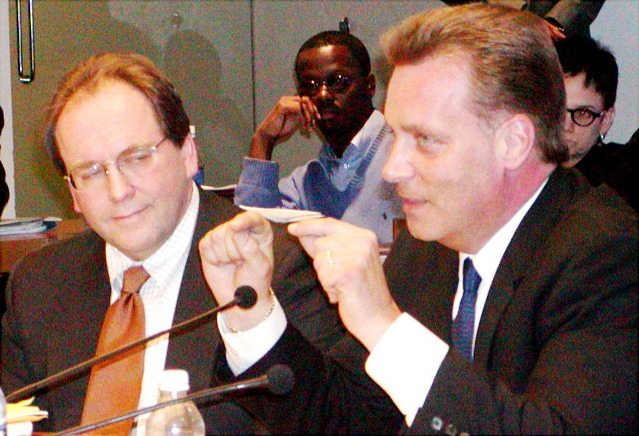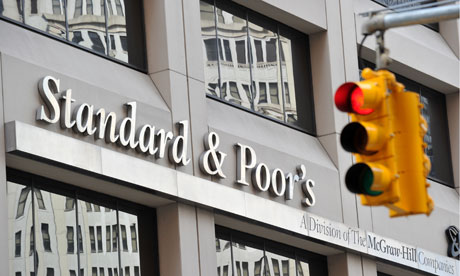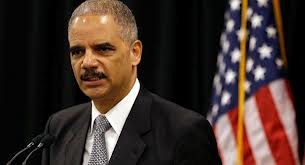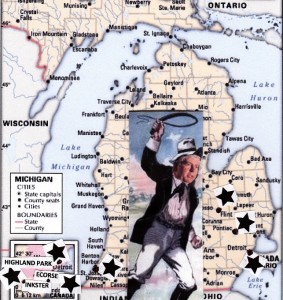
Stephen Murphy of Standard and Poor’s (r) speaks at Detroit City Council meeting Jan. 31, 2004 as Joe O’Keefe of Fitch Ratings listens smugly. They successfully pushed a hotly contested $1.5 BILLION pension obligation certificate loan on Detroit, from UBS (which just paid the USDOJ a $1.5 billion fine after admitting fraud), and its minority partner Siebert, Brandford and Shank. The Council finally caved under threat of lay-offs and credit downgrades. Detroit defaulted on the debt twice, after the market crashed in 2008. To prevent bankruptcy, the city agreed to have its casino taxes and revenue-sharing funds funneled through the U.S. Bank of NA as trustee, to ensure debt payments. Photo: Diane Bukowski
NO CRIMINAL ACTION TAKEN
By Aruna Viswanatha and Lauren Tara LaCapra
Tue Feb 5, 2013 6:03pm EST
(Reuters) – The U.S. government is seeking more than $5 billion in a lawsuit against rating agency Standard & Poor’s over mortgage bond ratings, U.S. Attorney General Eric Holder said on Tuesday.

Standard and Poor’s offices.
The civil suit against S&P and its parent McGraw-Hill Cos Inc is the first federal enforcement action against a credit rating agency over alleged illegal behavior related to the 2007-2009 U.S. financial crisis.
The government is accusing the ratings service of defrauding investors, in one of the most ambitious cases yet from the Justice Department over conduct tied to the financial crisis.
The United States said S&P inflated ratings and understated risks associated with mortgage securities, driven by a desire to gain more business from the investment banks that issued those securities. S&P committed fraud by falsely claiming its ratings were objective, the lawsuit said.

U. S. Attorney General Eric Holder.
“Put simply, this alleged conduct is egregious – and it goes to the very heart of the recent financial crisis,” said Attorney General Eric Holder at a news conference in Washington announcing the charges.
The 119-page lawsuit, filed late Monday in federal court in Los Angeles, is the first from the government against a ratings agency, a sector that has generally shielded itself from liability by citing First Amendment protection of free speech.
Sixteen states and the District of Columbia are also suing S&P, a unit of the McGraw-Hill Companies Inc. McGraw-Hill shares fell as much as 8.9 percent on Tuesday, after dropping 13.8 percent on Monday.

Neither Michigan’s Slavemaster Gov. Rick Snyder nor his ally Detroit Mayor Dave Bing have instituted lawsuits against S & P or any banks for the devastation they have wrought in particular on Detroit and other majority Black cities.
No individuals were charged in the DOJ’s lawsuit, and it was not immediately clear why the government focused on S&P instead of rivals Moody’s Corp or Fimalac SA’s Fitch Ratings, which were also major raters of such securities.
The 2007-2009 financial crisis was due in large part to massive losses triggered by risky mortgage loans packaged and sold to investors, often with top ratings from credit raters.
S&P issued a statement on Tuesday saying the lawsuit is meritless and that it will vigorously defend itself. It said the government “cherry picked” emails to misconstrue analyst activity.
“Claims that we deliberately kept ratings high when we knew they should be lower are simply not true,” the company said.
Senator Carl Levin, who led a year-long inquiry into the causes of the financial crisis and singled out credit raters for blame, said in a statement the public was “eagerly awaiting” legal actions tied to the financial crisis.
“The credit rating agencies have yet to acknowledge any blame or make the changes necessary to prevent conflicts of interest from fueling more inflated ratings in the future,” the Democrat from Michigan said.
YEARS-LONG BATTLE
A source close to S&P said the firm expected a years-long battle with the government over the lawsuit. Settlement talks recently collapsed, the source said, after the government sought a penalty of over $1 billion and admissions of wrongdoing, which would exposed the firm to outside liability.
“There was no fraud,” S&P lawyer Floyd Abrams said on CNBC Tuesday morning. “The ratings that were issued were believed by the people who issued them. And that’s what the government has got to disprove.”
Between September 2004 and October 2007, as stress in the housing market was starting to emerge, S&P delayed updates to its ratings criteria and analytical models, which weakened its criteria beyond what analysts believed was needed to make them more accurate, the Justice Department said.
During that period, according to the complaint, S&P issued credit ratings on $2.8 trillion worth of mortgage securities and some $1.2 trillion in related structured products.
It charged up to $750,000 per deal it rated, which meant that S&P viewed the investment banks that issued the securities as its main customers, according to the complaint.
In August 2004, the head of S&P’s commercial mortgage-backed securities sent an email to her colleagues and said they planned to meet to discuss adjusting criteria “because of the ongoing threat of losing deals.”
Earlier in May, an analyst wrote, “We just lost a huge Mizuho RMBS deal to Moody’s due to a huge difference in the required credit support level … our support level was at least 10% higher than Moody’s,” the complaint said.
S&P had planned in 2004 to update its model for rating mortgage securities by including a broader data set of past loans, which would provide more accurate comparisons for the more risky loans that were being packaged.
In 2006, S&P loosened assumptions on its ratings of collateralized debt obligations, which one of the firm’s analysts described as creating a loophole big enough to drive a Mack truck through.
Asked who came up with the idea, the analyst referred to a couple of colleagues and said: “I am interested to see if any career consequences occur. Does company care about deal volume or sound credit standards?”
By July 5, 2007, as the credit crisis began taking hold, a new S&P structured finance analyst told an investment banking client: “The fact is, there was a lot of internal pressure in S&P to downgrade lots of deals earlier on before this thing started blowing up. But the leadership was concerned of p*ssing off too many clients and jumping the gun ahead of Fitch and Moody’s.”
Six days later, the analyst alluded to a climactic scheme in the movie “Trading Places” by adding: “You should see how it is here right now. It’s like a friggin trading floor. ‘Downgrade, Mortimer, downgrade!!!'”
The next day, July 12, S&P announced a mass downgrade of 2005 and 2006 subprime residential mortgage debt.
OLD LAW, NEW TWIST
The lawsuit was brought under FIRREA, the Financial Institutions Reform, Recovery, and Enforcement Act, a federal civil fraud statute passed in the wake of the 1980s savings-and-loan scandals. It covers fraud affecting federally insured financial institutions.
While it has appeared in only a few dozen cases, its low burden of proof, broad investigative powers and long statute of limitations encouraged the Justice Department to dust it off for potential cases, especially after criminal inquiries failed to yield major prosecutions.
In its complaint against S&P, the Justice Department accused S&P of defrauding Western Federal Corporate Credit Union, and other institutions that purchased certain securities based on the high ratings by S&P.
Some credit unions are required by law to rely on credit ratings issued by firms that included S&P in making its investment decisions, the complaint said.
(Reporting By Aruna Viswanatha in Washington and Lauren Tara LaCapra in New York; Additional reporting by Emily Stephenson, David Ingram and Jonathan Stempel; Editing by Karey Wutkowski, Andrew Hay, Matthew Lewis and Tim Dobbyn)
Click on http://www.justice.gov/opa/pr/2013/February/13-ag-156.html for full release from USDOJ, including link to lawsuit.
Critical analysis from other sources will be forthcoming.




